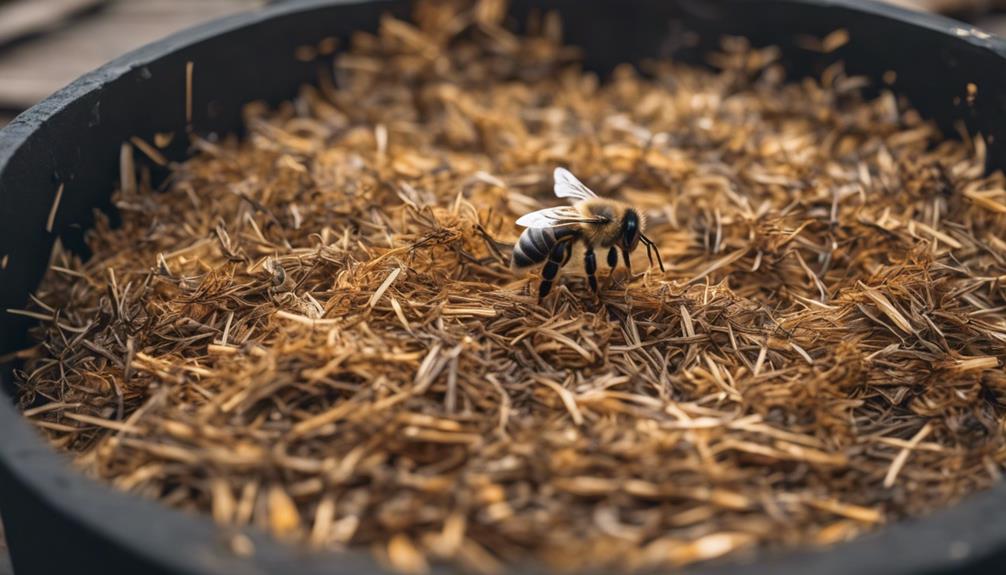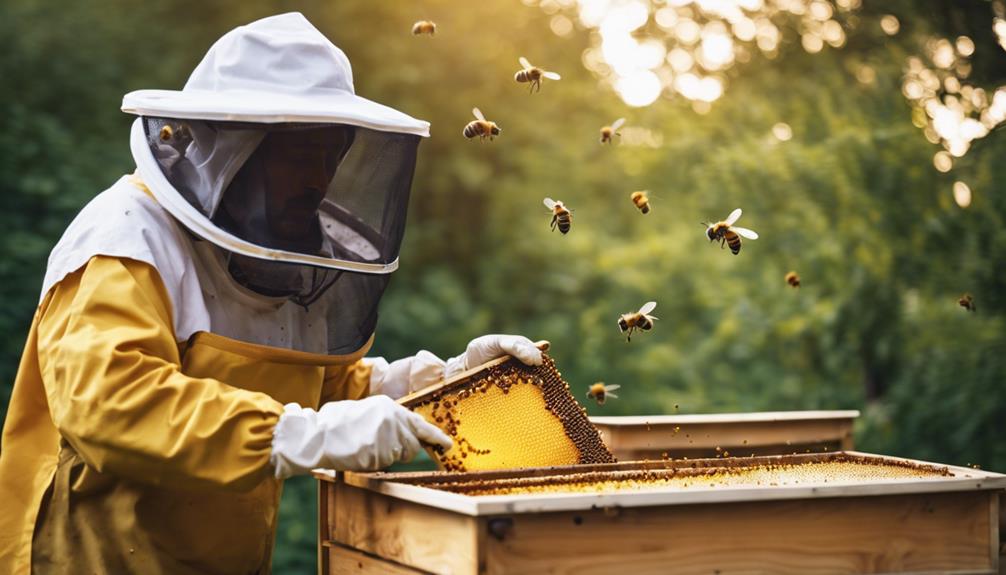When gearing up a bee smoker, pine needles hit the sweet spot as a go-to choice for beekeepers. They offer a reliable option, producing long-lasting smoke that helps maintain a peaceful vibe around the hive. Pine needles are efficient and readily available, ensuring a steady burn for keeping your bees calm during those important hive inspections and tasks. If you’re looking to discover more about other fuel options and how they can play a role in your beekeeping journey, this could be the first step to accessing a wealth of information that could benefit your beekeeping experience.
Main Points
- Pine needles are efficient, long-lasting, and reliable for calm hive atmosphere maintenance.
- Hessian is cost-effective, readily available, and helps create a peaceful environment.
- Paper, free of chemicals, burns cleanly, is cost-effective, and readily available.
- Cardboard, convenient for smoke production, produces significant smoke when ignited.
- Dried leaves are lightweight, sustainable, burn fast, and easy to collect for on-the-go beekeeping.
Pine Needles as Bee Smoker Fuel
When preparing a bee smoker, we typically start by gathering pine needles for fuel. Pine needles are a fantastic choice due to their availability and ability to produce smoke effectively. While they can create long-lasting smoke, it’s essential to be cautious as they might spark.
As beekeepers, we need to be mindful of potential clogging issues that could arise when using pine needles in the smoker. Despite the risk of sparking, many of us find pine needles to be reliable and efficient for maintaining a calm hive atmosphere.
Hessian Options for Bee Smokers
We’ve found that hessian offers some great benefits regarding bee smoker fuel.
The different types of hessian materials can impact how well the smoker functions, so it’s worth exploring the options available.
Understanding these hessian choices can help beekeepers make informed decisions for their apiaries.
Hessian Benefits for Smokers
Hessian presents beekeepers with a cost-effective and efficient option for fueling their bee smokers. This material burns well, producing a steady stream of smoke that helps keep our buzzing friends calm during hive inspections. Its durability and easy ignitability make it a go-to choice for many apiarists.
We love using Hessian in our smokers because it’s reliable and readily available. The peaceful environment it helps maintain in the bee yard is truly invaluable. With Hessian, we can focus on our beekeeping tasks without worrying about agitation in the hives. It’s like a secret weapon in our beekeeping arsenal, always ready to lend a hand in keeping our bees happy and productive.
Types of Hessian Materials
Moving on to discussing the varieties of Hessian materials accessible for bee smokers, beekeepers can investigate different options to find the most appropriate fuel for maintaining a peaceful atmosphere during hive inspections.
Hessian, known for its affordability and effectiveness in producing smoke, is commonly used in beekeeping. Beekeepers often opt for Hessian sacks or cloth strips as smoker fuel due to their ability to burn well and provide a steady source of smoke that helps calm bees during inspections.
The reliability and ease of use make Hessian a preferred choice for maintaining a consistent smoke output, aiding in managing bee behavior effectively. This traditional method has stood the test of time, offering beekeepers a reliable tool for ensuring smooth hive interactions.
Paper Considerations for Bee Smokers
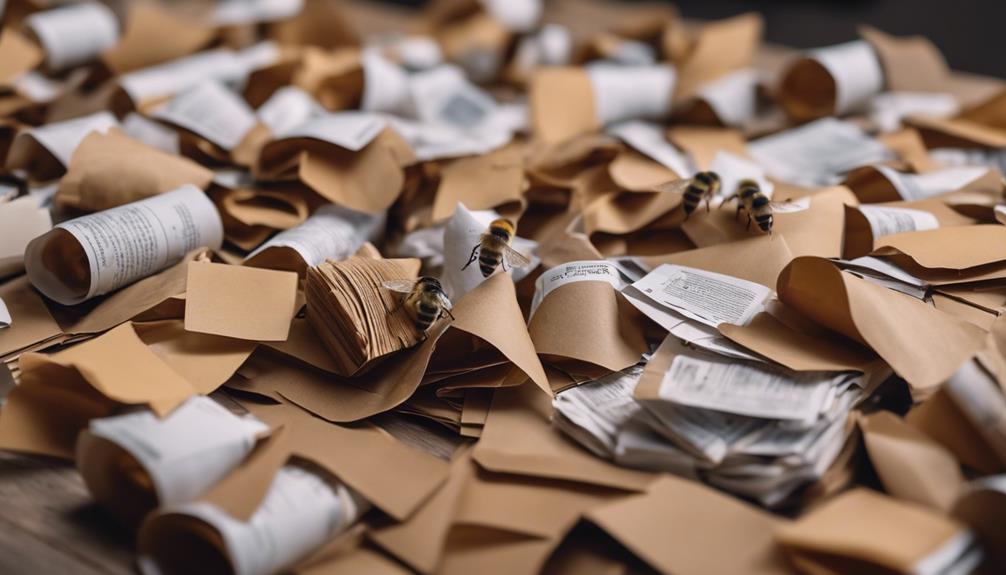
When selecting paper for use in bee smokers, it’s crucial to choose varieties free of chemicals, dyes, or glossy coatings to guarantee safe and effective smoking. Plain paper, like newspaper or unbleached varieties, can be torn or crumpled to create a quick-burning fuel for the smoker. These papers burn cleanly, producing a steady amount of smoke without leaving harmful residue.
Not only is paper a cost-effective option, but it’s also readily available to beekeepers. By opting for natural, unprocessed paper, you make sure that your smoker functions at its best without introducing any unwanted substances into the hive. So, next time you’re prepping your smoker, reach for that plain paper for a smooth and safe beekeeping experience.
Cardboard as Bee Smoker Material
Cardboard serves as a convenient and effective material for fueling bee smokers due to its ease of use and ability to produce a significant amount of smoke when ignited. When preparing your smoker for hive inspections or honey collection, consider cutting cardboard into strips for efficient burning and smoke production.
However, be cautious as cardboard can generate hot smoke, possibly overheating the hive if not managed carefully. Opt for clean cardboard to avoid exposing your bees to any potential adhesives or chemicals that could be harmful.
Dried Leaves for Bee Smokers
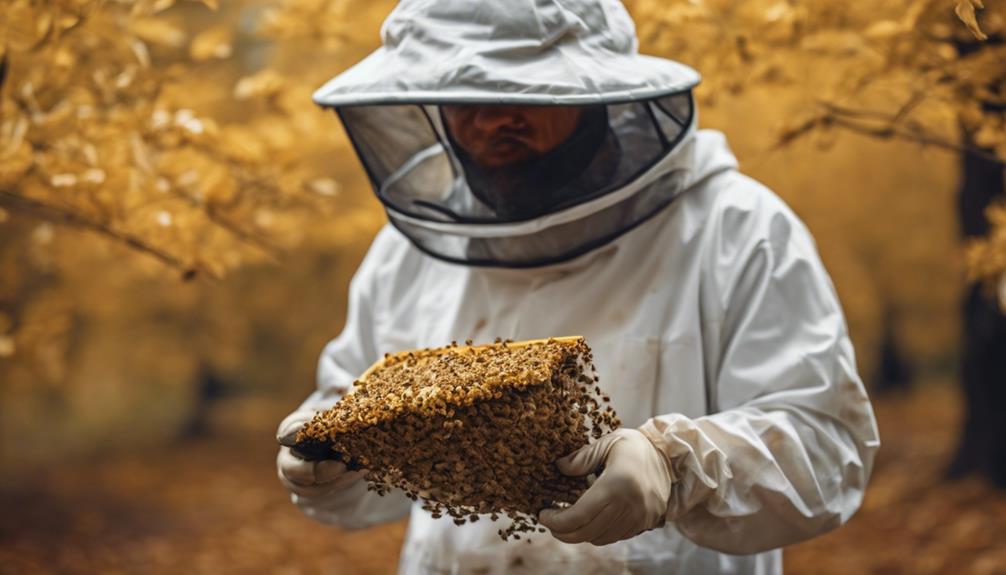
To introduce an alternative fuel option for bee smokers, dried leaves offer a convenient and efficient solution for generating smoke during hive inspections or honey collection. Dried leaves are a quick and accessible option that burn fast in a bee smoker, leaving minimal residue behind. They provide a temporary solution when other fuel sources are unavailable and are lightweight, making them easy to carry for on-the-go beekeeping needs.
Collecting leaves from the surrounding environment is simple, ensuring a sustainable and environmentally friendly way to keep your bee smoker fueled. So, next time you’re out inspecting your hives or harvesting honey, consider reaching for a handful of dried leaves to keep your smoker going smoothly.
Twigs in Bee Smoker Usage
In regards to bee smokers, branches play a vital role in generating the necessary smoke to calm our buzzing friends.
By utilizing dry branches, we can guarantee a quick burn and immediate smoke production for effective hive inspections.
Twigs for Smoke
We typically use dry twigs to efficiently generate calming smoke for bee smokers during hive inspections. When selecting twigs for smoke in bee smokers, there are a few key considerations to keep in mind:
- Dry Twigs: Make sure the twigs are thoroughly dry to promote quick-burning and effective smoke production.
- Moisture-Free: Twigs should be free of moisture to burn efficiently and create sufficient smoke.
- Small Twigs: Opt for small twigs to maintain a steady smoke output without overwhelming the bees.
- Controlled Smoke: Adding twigs to the bee smoker helps establish a controlled and manageable smoking process for beekeeping tasks.
Burning Techniques
For efficient burning and consistent smoke production in a bee smoker, consider bundling dry twigs of varying sizes to create a sustainable fuel source.
Twigs, being readily available and easy to ignite, offer a natural and cost-effective option for beekeepers. By selecting dry twigs and ensuring they’re free of moisture, you can achieve a steady burn that efficiently produces smoke.
Bundling these twigs together forms a compact fuel source that burns effectively in the bee smoker, providing you with the necessary smoke to calm the bees during inspections.
This technique not only helps in maintaining a sustainable fire but also contributes to a smoother beekeeping experience.
Smoke Control Tips
To improve smoke control in a bee smoker, incorporating a mix of small and large twigs can help regulate the intensity and duration of the smoke output. Here are some smoke control tips for using twigs in your bee smoker:
- Balanced Burn: Combining small twigs with larger ones guarantees a steady burn for consistent smoke.
- Sustainability: Twigs are easily accessible and can be a sustainable fuel source for bee smokers.
- Improve Quality: Mixing twigs with other smoker fuels can boost the quality and duration of the smoke.
- Effective Process: Properly dried twigs contribute to a well-controlled and effective smoking process in beekeeping.
Using twigs in your smoker not only aids in smoke control but also adds to the overall efficiency of your beekeeping practices.
Best Materials for Calm Hives
What materials are best for maintaining calm hives while utilizing a bee smoker?
When it pertains to keeping our bee friends relaxed, opting for cotton fuel is the way to go. Why, you inquire? Well, cotton offers that cool smoke bees love, keeping them in a zen state. Plus, it burns slowly, providing a sustained effect that keeps the hive chill.
On the flip side, burlap burns faster, which mightn’t give the same calming result. Remember, embers from the smoker can spell trouble for the queen bee if the fuel isn’t right.
Quick-Burning Options for Smokers

When searching for fast-burning choices for bee smokers, we can look to materials like cardboard, paper, and dried leaves. These items are readily available and ignite quickly, producing thick smoke ideal for soothing bees during hive inspections. Here are some quick-burning options to contemplate:
- Cardboard: Ignites rapidly for instant smoke production.
- Paper: Generates quick-burning smoke, perfect for brief hive inspections.
- Dried leaves: Convenient alternative when traditional fuel sources aren’t accessible.
- Other combustible materials: Can also be utilized for producing dense smoke effectively.
Having these fast-burning alternatives on hand ensures you can promptly create the dense smoke needed to keep the bees calm and manage your hive effectively.
Clean Fuel Choices for Beekeeping
In the case of clean fuel choices for beekeeping, selecting the right type can make a significant difference in smoke efficiency. Various fuel types offer different benefits and drawbacks, affecting the overall beekeeping experience.
Let’s investigate the advantages and considerations of using specific fuels to guarantee a smooth and productive beekeeping operation.
Fuel Types
For beekeeping, selecting clean fuel options such as cotton or burlap is crucial when filling a bee smoker. These natural materials offer advantages like cool smoke, long burn times, and minimal debris. Here are some fuel types commonly used for bee smokers:
- Cotton: Provides cool smoke and burns steadily.
- Burlap: Burns faster than cotton but still offers effective smoke.
- Pine needles: Can create sparks, making them less ideal.
- Corrugated cardboard: Generates lots of smoke but may contain resin.
Choosing natural materials rich in oil content, like cotton or burlap, guarantees a safe and efficient beekeeping experience with your bee smoker. Remember, the cleaner the fuel, the smoother your beekeeping adventures will be!
Smoke Efficiency
To guarantee peak smoke efficiency in beekeeping, selecting clean fuel options such as cotton or pine needles is essential. In terms of bee smokers, using pine needles can provide a long-lasting burn, ensuring you have a steady smoke source throughout your hive inspections.
Similarly, cotton offers a cool smoke that helps keep bees calm and collected, making your beekeeping experience smoother. Remember to avoid burlap, as it burns quickly and may produce dangerous embers that could harm the queen bee.
Additionally, while corrugated materials like cardboard generate hot smoke, they can contain resin that might clog up your smoker. Stick to natural, clean fuels like cotton or pine needles for a safe and efficient beekeeping environment.
Ideal Fuel for Beekeeper Activities
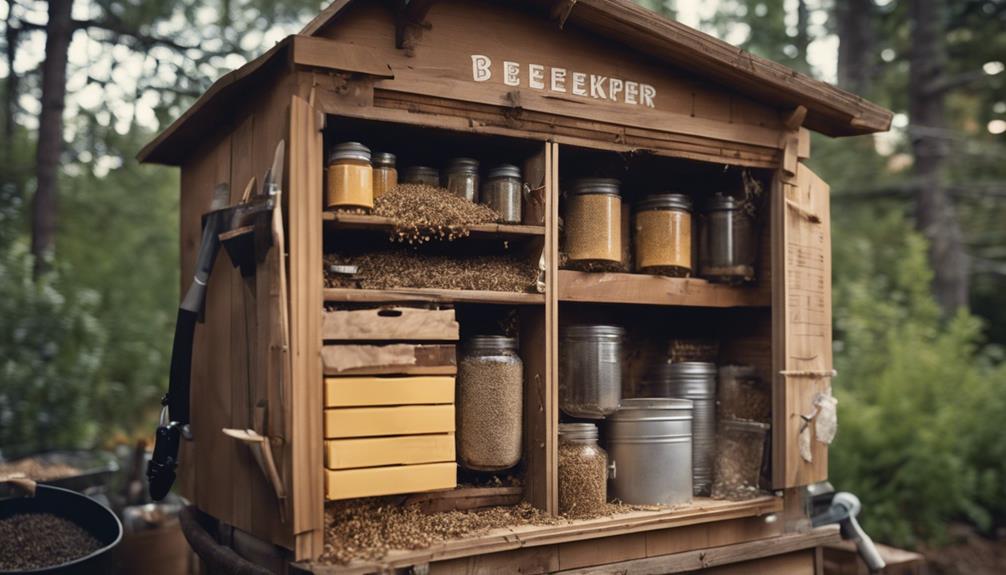
Our preferred choice for fueling bee smokers during beekeeper activities is cotton due to its ability to produce cool smoke that calms bees without causing harm. When engaging in beekeeping tasks, having the right fuel for your smoker is essential for maintaining a peaceful hive environment. Here are some reasons why cotton is our top pick:
- Long-Lasting Burn: Cotton fuel burns slowly, providing sustained smoke for hive inspections and honey collection.
- Queen Bee Safety: Embers from other fuels can pose a risk to the queen bee, making cotton a safer option.
- Calming Effect: The smoldering nature of cotton smoke helps keep bees calm during manipulations.
- Efficiency: Compared to burlap and wood pellets, cotton offers a more efficient and controlled burn, ideal for various beekeeper activities.

Hello! My name is Noel Calvin. I graduated from UCLA and now work as a writer at Launch Ninjas. I write blog posts that inspire and guide our readers in their entrepreneurial pursuits. I live in Pleasantville, NJ, with a peaceful yet lively atmosphere that inspires me.
Writing stories is more than just a job for me. It allows me to share my observations and satisfy my curiosity about the world. I combine my analytical skills with creative enthusiasm to delve into technology trends and startup stories. But my life isn’t limited to screens and keyboards. I value loyalty, passion, and a touch of old-fashioned charm, which I infuse into every narrative I create.
I love spending time in my garage, jamming with my band when I’m not writing. Playing the guitar and singing bring me immense joy. I also enjoy capturing ordinary and extraordinary moments through my camera lens and exploring new culinary adventures that excite my taste buds. I’m always seeking new experiences.
My family is very important to me. Joyful Sunday brunches filled with laughter and intense board game nights keep me grounded, reminding me of life’s simple pleasures.
In my world, every moment is an opportunity for discovery. Every discovery is a story worth sharing, whether a heartfelt moment at home or the pulse of technological innovations. Join me as I navigate through life, one blog post, one guitar strum, and one heartwarming family dinner at a time.
